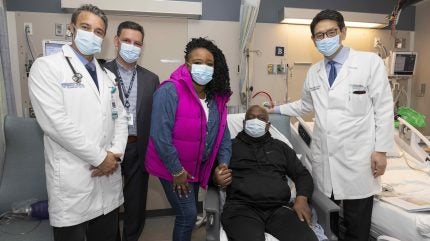
The first patient to receive a genetically modified pig (porcine) kidney has been discharged from hospital, marking a significant step for the developing xenotransplantation sector.
62-year-old Richard Slayman had been suffering from end-stage kidney disease and had been a patient at the Mass General Transplant Centre for 11 years.

Discover B2B Marketing That Performs
Combine business intelligence and editorial excellence to reach engaged professionals across 36 leading media platforms.
Slayman underwent the four-hour-long surgery on 16 March and was discharged from Massachusetts General Hospital (MGH) on Wednesday in what he called “one of the happiest moments of my life”.
The pig kidney implanted into Slayman was provided by eGenesis and genetically edited using CRISPR-Cas9 technology. A total of 69 modifications were made to improve compatibility and reduce the risk of rejection – the most common issue with both allo- and xenotransplantation.
Historically, another major concern in the field of xenotransplantation has been the risk of xenozoonosis – the spread of disease from animals to humans via a diseased organ. Even in allotransplantation, there is some risk of bacterial, fungal or viral infection spreading from a donated organ, although, in the case of kidney transplants, fewer than 0.1% are serious.
To address this for Slayman’s transplant, scientists inactivated porcine endogenous retroviruses in the pig donor.

US Tariffs are shifting - will you react or anticipate?
Don’t let policy changes catch you off guard. Stay proactive with real-time data and expert analysis.
By GlobalDataThe successful xenotransplantation of a pig kidney is representative of a field that is growing, according to GlobalData medical analyst Graysen Vigneux. He considers the area to be “fueled by advancements in genetic engineering and medical technology” and notes that “it is likely that we will see more transplants from animals into humans in the future.”
The significance of a successful xenotransplant
The successful xenotransplantation of a genetically modified pig kidney could have immense ramifications. According to the United Network for Organ Sharing (UNOS), 17 people die a day in the US waiting for an organ, and around 1,500 are added to the waitlist each week. Of these, around 1,000 are waiting for kidney transplants.
Mike Curtis, CEO of eGenesis, believes the transplant represents a “new frontier in medicine”, which “demonstrated the potential of genome engineering to change the lives of millions of patients globally suffering from kidney failure”.
Vigneux too is hopeful that the xenotransplantation field could change the accessibility of a range of organs.
“While the kidney is currently a focus for xenotransplantation due to its suitability and the prevalence of kidney failure, other organs, such as the liver, pancreas and heart, may also be considered for transplantation from animals in the future,” he says.
“Each organ presents unique challenges and considerations, but advancements in genetic engineering and immunosuppressive therapies could expand the possibilities for successful transplants.”
Indeed, porcine transplants have been viewed as promising for the treatment of organ failure for some time, but previous attempts to transplant genetically edited hearts have been unsuccessful. David Bennett, the first man to receive a genetically modified porcine heart in 2022, died two months after the procedure.
Transplants from other animals have also been attempted. In 1984, a baboon heart was transplanted into Baby Fae, who died three weeks later. It was preceded by the first-ever heart xenotransplant in 1964, which used a chimpanzee heart. The heart beat for 30 minutes, but the patient, Boyd Rush, never regained consciousness.
Now, MHG’s medical director for kidney transplantation Leonardo Riella hopes that the tide has turned for xenotransplantation.
“70 years after the first kidney transplant and six decades following the advent of immunosuppressive medications, we stand on the brink of a monumental breakthrough in transplantation,” he is quoted as saying.





